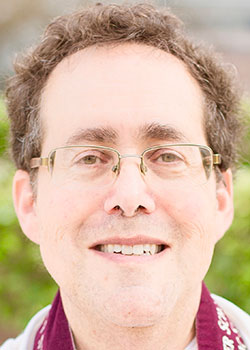I love LA after it rains. The water dries, and for at least a brief time, the showers clear the air and wipes away the smog that sits heavily around the city. In those moments, from atop the hills of Bel Air where American Jewish University is located, you can see clearly for miles - actually witnessing the beauty of the mountains, the valley, the clouds, and from one spot close to campus, even a sliver of the ocean shore. But last week, after a particular unseasonably early rain shower, as I was driving off the hill, I looked up and added to the beauty was the colorful arch of a rainbow.
As I continued on my journey, I recited the traditional blessing for seeing a rainbow: Baruch ata Adonai Eloheinu melech ha'olam zocher ha'brit v'ne'eman bivrito v'kayam b'ma'amaro. Blessed are You, Lord our G-d, King of the universe, who remembers the covenant, and is faithful to His covenant, and keeps His promise.
Apparently, I was not the only one in Los Angeles to take note of this awesome symbol of nature. By the time I got home and turned on my computer, dozens of people had posted pictures on Facebook, with some version of the status update that affirmed the beauty, the wonder, the joy of having witnessed the rainbow. And, it was even one of the top stories on the evening news. At some point of the evening, however, I remember going back to the words of the blessing and its representation and thinking that the rainbow arrived a week earlier than it should have for it is this week when we read the biblical story of Noah, in whose narrative, we are first introduced to the rainbow.
After the Great Flood that destroys the world save Noah, his family and the animals he places in the ark, God shows Noah the rainbow in the clouds, promising that he will never again destroy humans, and that the rainbow will be: "... a sign of the covenant that I have established between Me and all flesh that is on earth." (See Genesis 9:8-17)
Perhaps because they are so few and far between, perhaps because of their beauty, or perhaps because of their meaning - whatever the reason, we all know there's nothing quite like the rainbow, the beautiful arc of color that results when light is refracted and reflected in water droplets. And, through the striking arrangement of color - red, yellow, blue, orange, purple, and green, we envision the possibility of success, hope, and tolerance that the rainbow has come to symbolize. The Biblical commentator, Ramban (Nachmanides), points out that the rainbow was already an existing natural phenomenon which is from this moment on, invested with new significance as an eternal testimony of God's mercy and of God's eternal presence. So, each time we see a rainbow, we will realize that it rained... and, it stopped. Recognizing that this rain was not another GREAT FLOOD, we recognize that God has indeed kept the promise he made to Noah.
A keshet, the word used in the biblical narrative to connote the rainbow, is also the word used for a bow, as in the bow used with an arrow for destruction and in attack. In the Jewish Publication Society Bible commentary, Nahum Sarna suggests that our understanding of rainbow as a symbol of the covenant is a specific departure from other Ancient Near Eastern notions of the bow as a sign of war, military victory, and dominance. Through the story of Noah, Sarna says, 'hostility is transformed into a token of reconciliation between God and Man.'
Returning to Rambam, then, it makes sense that he also points out that while a bow can also be a symbol of violence - since the bow and arrow serves as a deadly weapon, a rainbow points the bow away from humanity. As in battle, turning the bow away from your opponent communicates a cessation of fighting. Furthermore, the rainbow lacks any parallel to the string used to shoot the arrow. Thus, the physical makeup of the rainbow indicates an end to destruction and a promise of peace.
So as it is with God and Man, so it should be man and man. And, it is for this reason that I think the rainbow has become such a universal sign of hope, courage, tolerance, creation, and meaning. For we understand that we are not only seeing rainbows, but we have the power to become the rainbow. In the words of Maya Angelou: 'God put the rainbow in the clouds, not just in the sky'. It is wise to realize we already have rainbows in our clouds, or we wouldn't be here. If the rainbow is in the clouds, then in the worst of time, there is the possibility of seeing hope. We can say 'I can be a rainbow in the cloud for someone yet to be.' That may be our calling.
In a world with so many bows and arrows (literal or metaphorical), we have to turn our arrows away from one another to end destruction and bring about civility, peace and true acceptance. We live in a world of infinite hope and possibility and we - the rainbow- have the power to help end war, to help civil discourse become a true exchange of ideas, and to be sure that all people - regardless of gender, age, color, nationality, sexual orientation, social stature, or any other category - are recognized as endowed by our creator and can enjoy the unalienable rights. If each of us did this in our own piece of the world, imagine the 'watershed' that would reflect and refract into the world as a beautiful arch of color.
Ken yehi ratzon - so may it be! Shabbat Shalom

